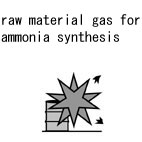| Case Name |
Sudden explosion of the combustion gas at a low-temperature liquefaction separation plant |
| Pictograph |

|
| Date |
July 11, 1959 |
| Place |
Ube, Yamaguchi, Japan |
| Location |
Chemical factory |
| Overview |
Explosion and fire occurred at the plant which liquefied at low temperature and separated carbon monoxide and methane from the gas which was generated by partial combustion of the crude oil. The explosion occurred two times, and 11 persons were killed, 44 persons got injured. Nitrogen purge of the combustible gas in the reactor was done as the first fire extinguishing action. However, more intense explosion occurred after two hours. Aliphatic nitro and nitroso compound generated in the first explosion seemed to have exploded. It was presumed that the second explosion was caused because cold insulators were combustibles. By liquid nitrogen used for low temperature separation, the oxygen was concentrated in cold insulators. The combustible insulator including oxygen- rich air exploded. |
| Incident |
Explosion occurred and fire broke out at a plant which liquefied and separated carbon monoxide and methane in the gas which was generated by partial combustion of crude oil with steam. Nitrogen gas was introduced in order to purge combustible gas of which hydrogen was the main component. However, more intense explosion occurred after two hours. In the second explosion, 11 workers were killed and 44 workers got injured. |
| Processing |
Manufacture |
| Individual Process |
Separation |
| Process Flow |
Fig2.Unit process flow
|
| Substance |
Gas mixture for the synthesis of ammonia (hydrogen, nitrogen, methane,argon etc) |
| Type of Accident |
Explosion, fire |
| Sequence |
The first explosion occurred in the separator of an ammonia synthesis plant at 9:43 on July 11th, 1959, and fire broke out. Emergency measures such as the purge of combustible gas of the reaction system were carried out immediately, and fire extinguishing work was carried out. The second explosion happened at 11:45 during fire fighting. |
| Cause |
Dienes such as butadiene were generated from the reaction in the gasification furnace. Nitrogen oxides such as N2O3 and N2O4 were included in the water which was used at the water scrubber of carbon dioxide. Part of the nitrogen oxides dissolved in hydrocarbons, which liquefied due to low temperature separation, reacted with a diene compound, generated aliphatic nitro and nitroso compounds that are unstable and have big explosion powers. They are supposed to have accumulated and to have exploded. The cause of the second explosion is supposed as follows: cold insulators of the low temperature separator were combustibles (wool chips). A part of air in the cold insulator liquefied because the low temperature separator was at very low temperature, -192 °C, and the oxygen concentration in the air increased, thus the cold insulator exploded. |
| Response |
Purge and fire extinguishing work of combustible gas were carried out. |
| Countermeasures |
1. Cold insulators of the very low temperature equipment should be incombustible materials such as perlite.
2. Materials used in the process are chemicals, even wash water. Impurities contained in such materials should be cared. The industry or people related to safety should prepare the system to follow the similar accident cases. |
| Knowledge Comment |
1. Aliphatic nitro and nitroso compounds that are reactive might be generated, when the oxide of nitrogen liquefied at a low temperature dissolved into hydrocarbon. They are unstable and have strong explosion power.
2. At a low temperature of 192 °C, the oxygen in the air might be concentrated unexpectedly. It is necessary to consider that the unexpected situation can happen under the extreme condition. |
| Background |
1. Hazard analysis of the process was insufficient.
2. The fact that the oxygen in the air was concentrated in the cold insulator of the extremely low temperature equipment was not known, so combustibles were used for the cold insulator.
However, these factors might have been unpredictable in the technological level at that time. |
| Incidental Discussion |
It was recognized that the cold insulator for extremely low temperature had to be nonflammable based on this accident. |
| Reason for Adding to DB |
Example of an explosion accident caused due to unexpected explosives generated from byproducts |
| Scenario |
| Primary Scenario
|
Poor Value Perception, Poor Safety Awareness, Inadequate Risk Recognition, Insufficient Analysis or Research, Insufficient Prior Research, Insufficient Analysis of Danger, Ignorance, Insufficient Knowledge, Convincement, Usage, Operation/Use, Accumulation of Impurities, Bad Event, Chemical Phenomenon, Abnormal Reaction, Secondary Damage, External Damage, Explosion, Bodily Harm, Death, 11 person died, Bodily Harm, Injury, 40 person injured, Loss to Organization, Economic Loss, Direct Monetary Damage 240 million yen
|
|
| Sources |
Japan property insurance association, The disaster case, Fertilizer plant, Fire prevention guideline 11, Petrochemical industry fire prevention and explosion-proof guideline, pp.128-130(1970).
Industrial accident case study association, Oxidizing gas, the explosion (Industrial accident examples 1), pp.130-131(1971).
Tetsuzo Kitagawa, Explosion of the low-temperature liquefaction separator. Analysis of the explosion hazard, pp.87-102, pp.87-100(1980).
Japan property insurance association, Disaster case, by impurity and by-product. Fire prevention guideline 15, Fire prevention and explosion-proof guideline of the plant operation, p.101(1971).
Chemical Industries Association of Japan, The accident disaster case, Hydrogen purification unit, Accident disaster case and countermeasure, 4, safety countermeasure technology of the chemical plant, pp.316-317(1979).
|
| Number of Deaths |
11 |
| Number of Injuries |
44 |
| Physical Damage |
The facilities destruction in the factory |
| Financial Cost |
¥ 240 million (Fire prevention of the operation of the plant) |
| Field |
Chemicals and Plants
|
| Author |
OGAWA, Terushige (Graduate School of Environment and Information Sciences, Yokohama National University)
TAMURA, Masamitsu (Center for Risk Management and Safety Sciences, Yokohama National University)
|
|